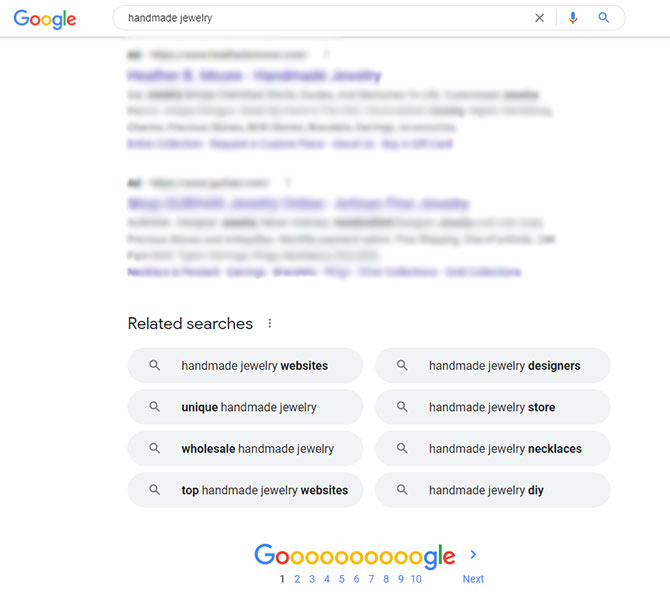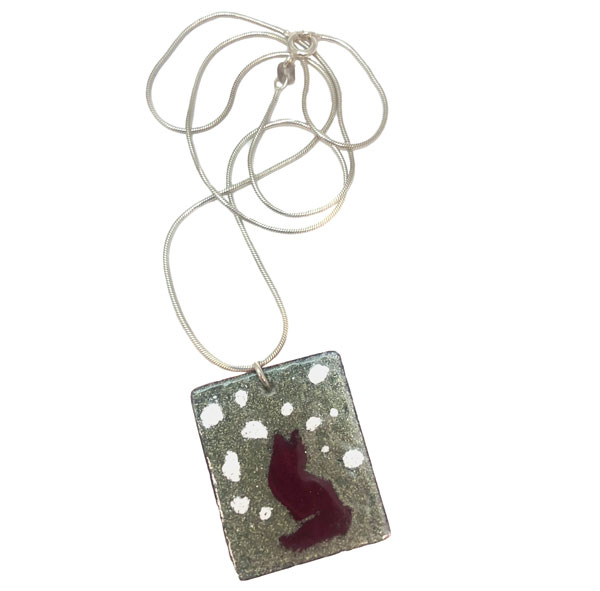Succeeding in today’s digital retail world means much more than simply having a website and social media presence. Once you’ve decided to put in the time and effort to have your own website, you want to make sure it will help promote your business. This is where the world of Search Engine Optimization (SEO) comes in!
If you don’t have your own website yet, now is the time to get it going! Make it easy by using one of the most popular eCommerce platforms. Many of these platforms have templates to make the build process easy and will help establish your Jewelry SEO right away by incorporating some of these tips. If you’ve had your jewelry business website for a while but want to see traffic growth – these tips will help you out!
SEO for jewelry is complicated and will take time to understand and implement well. So if you can take away these key points, you’ll be ahead of many others in the game:
- Have a fast, well-functioning website that’s easy-to-use.
- Write your website copy as if you’re speaking with a person and let your keywords naturally flow in the writing.
- Optimize and use images/video to your advantage
- Have a digital presence off your website as well – Google Business, review sites such as Yelp, other trustworthy websites.
What is SEO?
SEO, or Search Engine Optimization, is making your website (and online presence in general) friendly for search engines such as Google, Bing, etc. Although there are a variety of search engines, most digital marketers focus on Google since they have over 90% of the worldwide search engine market. Undeniably, Google is the king of online searching.
Google has gone through several phases since its inception. Initially they ranked websites based on keyword usage. As you can probably imagine, this led to a lot of websites artificially ranking high because they would put keywords in random places that made no sense – some were even known for adding text in the same color as the background to secretly add the keyword even more. Over time, Google caught on and cracked down on this “keyword stuffing”. Today’s Google rankings care more about user experience than how many times you can fit a certain phrase into the text. Is your website fast? Mobile friendly? Providing the information or products a user is looking for? Is it relevant and updated? If so, it may be rewarded with higher rankings.
There are a lot of factors that play into the Google algorithm and they change frequently so we’re not going to go into too much detail on them. The most important things to think about are: Meaning, Relevance, Quality, Usability, and Context.
- Meaning: Google wants to understand the intent of a search. For example, if a user is looking to purchase something vs learning how to make it themselves.
- Relevance: Google determines if a webpage is similar to a search based on keywords used as well as if a site uses pictures/videos of the keyword. They also base it on similar searches from other users and how useful they found a webpage.
- Quality: This is where Google determines how reliable and trustworthy a source is. We’ll talk about backlinks a little later, but this is where having your website linked on other websites is useful – especially those that Google considers of high quality already.
- Usability: Google will make sure your site is easy to use in different browsers, on various devices, and if the pages load quickly even for those users with slower connections
- Context: Google uses a searcher’s location and past searches, as well as a person’s search settings, to show results relevant to them.
Using Local SEO Rankings for Your Jewelry Business
But how can a small jewelry business compete with the jewelry giants when it comes to SEO and online rankings? The short answer: You probably can’t. At least not with generic search terms targeting everyone across the country. This is where your local rankings will help your business.
Local SEO rankings help searchers find businesses in their area. They’ll still show the major chain retailers in your area, but if you optimize your own listings, you’ll be able to compete with them! You will need good SEO practices in place on your website for these local ranking tips to be most effective. So be sure to read our tips further in the article.
If you don’t have a physical location that customers can visit, skip ahead to our general website SEO tips.
Google Business Profile
For physical locations, your best SEO tool is the Google Business Profile. Fill out the profile as completely and descriptively as you can. You must have an address that a customer can visit during the hours you state in order to have this profile. Some businesses can hide their address by saying they service a specific area, but keep in mind that if Google decides your information is not accurate they may decide to suspend your profile. Don’t lie to Google. Google also doesn’t allow business profiles with the same address. If your studio or store is in a building with multiple businesses, you should have an identifier such as Suite – this is allowed. If you’re in a building that doesn’t have this identifier, you may want to contact Google support if you’re hoping to set up a profile.

Once your business profile is complete, this opens new and helpful doors on Google! When someone searches for a local jeweler, your business may appear in the “map pack” that precedes search results. This is a list of local businesses that Google has decided are physically close enough and digitally relevant enough to the search for a person to visit. Ideally, you’d want to be in the first 3 that show up. But searchers who click on “More Places” will see more of the top results. The better your business profile information, the more a potential customer will see. The more information they have, the more likely they’ll pick your business over another one listed.

On your own website, embed the Google Maps location of your business on the Contact page. This tells Google that the address is correct and trustworthy for their users! It also keeps potential customers on your site instead of having to search Google Maps again.
Other Online Directories
Google is most popular for searchers, but where do potential customers go when they’re trying to decide between multiple businesses? Review sites. Yelp being the most popular. Claim these pages! When a potential customer sees “claimed” and “verified by business” it instills trust in your business and the information they're seeing on the directory listing. Often, they’re able to immediately go to your website, make a call, or get directions straight from the review site if it’s claimed. Make it easy on your customers.
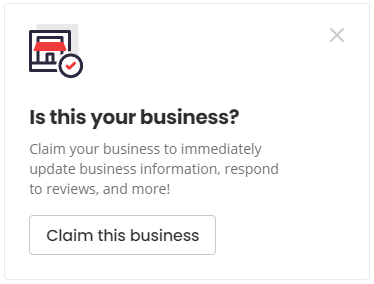
You don’t have to hunt down every single listing that exists for your business (there are a lot of directory sites) but you should at least try to claim the most popular ones - do your own search and see which review/directory sites come up. Generally speaking, these pages are free, although you can choose to advertise on them to promote your business. There are services, such as Moz Local, that allow you to claim and control your business listing on all of the top directories from one dashboard. These are paid services, but you may find it worthwhile in order to fully interact with all of these directories. They’ll tell you which sites your business is currently listed on, what information is listed, and let you correct your information as needed as well as add your business to others.
Claiming these pages can also help your Google SEO! Google likes seeing that your business Name, Address, Phone Number (NAP) is the same across multiple sites. If Google has one address, Yelp has another, and another directory has a third – Google won’t like that.
SEO For Jewelry Business Websites
Even if you have a physical location and use all of the local SEO tips above, you still need to have good website SEO for your jewelry business to rank well in those local rankings.
On-Site SEO for Jewelry
Let’s start by making sure your jewelry retail site is Google search friendly. If you play by Google’s rules, your site will perform well. If not, you risk your website having problems with searches. Number one rule: DO NOT KEYWORD STUFF. It’s an old tactic that Google now punishes. Their AI is smarter than most humans and understands contextual clues and paragraphs/sections as a whole.
Have a Good Website
If you’re using a platform like Shopify, you’re off to a good start! The top e-commerce platforms tend to follow the trends for quality and user-friendliness. What makes a good site? Right now, Google is focused on user-friendliness, speed, and mobile friendliness. Some other things to think about: Does your site have a helpful search function? Are your categories well-organized? Do you have filters available? Do your pages load quickly (we’re talking fractions of a second here)? Does your website look and run just as well on mobile devices?
In addition, your website should look nice. This may not directly affect SEO, but if your jewelry e-commerce site looks like it was built in 2005 it may affect your reputation with your users. The longer your users stay on your site, the better for your SEO. So someone visiting and immediately leaving because your website doesn’t look nice or run well isn’t going to help you. Platform templates are going to be fairly up to date with a sleek, modern look. However, if you’re using a custom platform or just haven’t done much with your overall brand look for a while you may want to consider changing it up. Check out our tips for creating your jewelry brand.
Fix Technical Issues
Your website should be clear of any major technical issues. Use the tools below to monitor your website for any technical issues and fix them if they come up. Broken links tend to be one of the biggest culprits. For example, let’s say you write a blog post that mentions and links to a specific piece of jewelry. If that piece is no longer available and taken off your website, that link is broken. Or if a URL changes, make sure you update any links. The tools below can help you identify and solve any technical problems. Your website platform may also have tools to help identify and fix these issues.
- Google Developer Tools (you don’t have to be a developer, they have simple tips for business owners as well)
- Google Search Console – this connects to your site and helps you understand any technical problems Google is having with it
A key point to remember when you’re optimizing your website is that Google is your friend – even though they also cause many of the changes. They want your site to run well and look good because they only maintain their reputation and make money when their users find exactly what they’re looking for. They also usually provide a generous heads-up for any major updates they plan to do so you can get ahead on making any changes to make sure your website is still in compliance when the new rules hit.
Do Keyword Research
You need to have an idea of the keywords that will best describe your jewelry business and pieces. For example, let’s say your jewelry collection is geared toward pet lovers. You have an assortment of dog and cat related pieces – maybe even horses or hamsters. Start by listing out phrases that describe your jewelry – more than one word. Dog jewelry, dog mom jewelry, etc. Keywords should be phrases. Don’t attempt to rank for the single word jewelry.

Be specific when you’re thinking about keywords. Think about what makes your jewelry unique and/or what someone might search when they want your designs. Google wants their users to be happy with the results, so think like a customer. Most likely, a customer isn’t going to search for a single word like jewelry – they're going to have a specific person, theme, occasion, etc. in mind that will turn into a keyword phrase.
Next, pull up Google and type in some of these phrases. At the bottom of the page you’ll see a list of related searches. Do any of related terms work for your jewelry? Add them to your list!
Google has a keyword planner tool. You’ll need to setup a Google Ads account to access it, but it’s free and doesn’t require running any ads. In there, you can put in keywords related to your business or copy your website URL and Google will scan it to give you suggestions. You can also see what the search volume is for your keywords, so you have an idea of which ones are searched a lot or only a few times. Don’t rule a keyword out just because it’s not searched thousands of times. If it’s unique and fits your jewelry designs, go for it. Note that running ads will also help your SEO, however the success rate of running ads can be hit and miss so you'll want to think about your budget and if you're willing/able to spend this money. Budgets can run from small $50 campaigns to thousands of dollars for larger businesses.
The Keyword Conundrum
How do you use your keywords? As I said earlier: Do not keyword stuff. Don’t put your chosen phrases in every other sentence to make sure it’s on your site. You of course want to use your keyword, or similar variations, in your text (think: repeating dog jewelry 5 times versus adding in jewelry for dog lovers, dog necklace, etc. – Google will understand the context of your phrases being similar). Add your main keyword to your headers if it makes sense (I.e. your product name, which is typically going to be your largest header (H1 or H2 depending on how your shopping platform sets everything up). Put a keyword in your image alt tag and image file name (more on that below). Just remember that in any writing for your customer, write as if you're speaking to them so your wording is natural. Then go back and see if you've used your keyword and add it in where it makes sense.
Whenever possible, you also want to assign different keywords to each page, otherwise you’re competing against yourself. Sometimes you may not have a choice based on how similar each jewelry piece is.
Have Good Product Descriptions
Once you know which keywords you want to focus on, incorporate them into your product names and descriptions on your website. If you create unique names for your pieces of jewelry, you will want to add a little more info in your description as people are most likely not going to search for that exact name. If you don’t name your jewelry pieces, don’t just put “necklace” as the product name. Let’s use this fox necklace as an example.
|
|
DO |
DON’T |
|
Item Name: |
Snowy Fox Enameled Necklace |
Fox Necklace |
|
Item Description: |
The perfect gift for the fox lover in your life! This enameled pendant evokes the calmness of winter as the red fox enjoys the first fall of snow. Size: 1” x 1.5” Enameled copper pendant on 18” sterling silver chain. |
Enameled fox necklace. Size: 1” x 1.5” |
Be descriptive! On the don’t side of this description, you only have a few very broad keywords for Google to associate with the product. On the do side we talk about a gift for fox lovers, a winter fox, a red fox, etc. But notice how it doesn’t say “fox necklace” 3 times? Google will be able to pick up on what the product is even if those words are not directly next to each other multiple times. It also gives the user a more detailed description of what exactly they’re looking at. If you offer customizations on a product, be sure to put that in the description as well.

You may also decide to look into setting up a Google Merchant account, where searchers can buy your jewelry directly from their Google search.

Meta Description
If your e-commerce platform lets you edit and customize the meta description of a page, I’d highly recommend you do this. The meta description is what shows up in a Google search! Don’t stuff your keywords in, but write an enticing description that includes a keyword or two to encourage Google to show it and a user to click on it. Google may create their own meta description by pulling from information in your product description, but editing your meta description allows you to add extra detail that Google may pull into the search results.
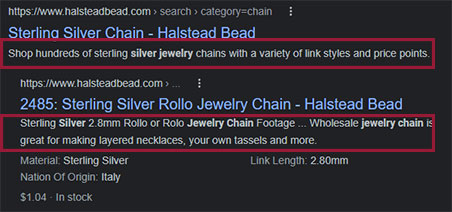
Have SEO Friendly Content
Creating SEO friendly content for your jewelry business is a lot easier than you might think. Google loves seeing websites being updated because it shows you’re still an active brand and providing useful and relevant information or products.
Blog
One of the easiest ways to consistently update your website is to have a blog. You don’t have to post every day or even every week but try to have an active and updated blog. Your content can be short, informative, and entertaining. Unless you want to try ranking for an informative topic, your blog posts should be about 300-500 words. It may not drive a lot of traffic to your site, but it will keep it fresh and keep customers coming back (which helps your SEO!). Having informative blogs will also keep customers on your website longer. So even if there are a million other blogs about taking care of jewelry, write one for yours as well. Check out our tips for creating jewelry content.
Images
Use good image SEO! Having high quality images signals to Google that your website is high quality. You can also optimize your images by including keywords in the image file name and adding alt tags. Alt tags are not necessarily visible, but they’re important for a few reasons. The alt tag of a photo is a description that’s generally only seen in the coding of your website. This is what Google reads when they crawl your website with their bots. The more descriptive the alt tag, the more it helps with your SEO. But they’re also used for accessibility purposes. When a sight-impaired user is on a website, they often use a screen reader to “see” the website. The screen reader will use this alt tag to read the image to the user. Again, the more descriptive the alt tag, the better. Being told an image is of a “necklace” doesn’t help a person. Being told an image is of an “enameled pendant with a red fox and snow flurries” gives the user a better idea of what the website is showing. Your website platform should have a way to add these alt tags when you upload images. Check out our tips for taking your own high-quality photos.
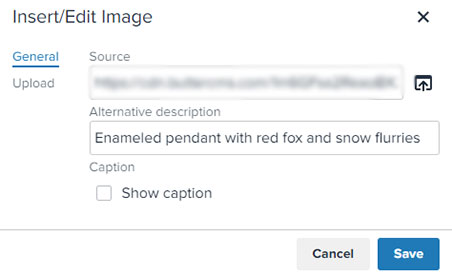
Contact Us Page
Google likes knowing that users can reach you if they have any questions. If you’re using a platform, such as Shopify, there’s likely a Contact page template you can use that is coded to tell Google what that page is. If you have a public address be sure to include it here in addition to your email and phone number.
Reviews
Whether they’re on their own page or on each product page, having reviews available is extremely helpful for SEO since they help provide a better user experience. Using Google Reviews will also allow those reviews to show in the searches and listings. Many website platforms have ways to collect reviews on-site or additions/plug-ins to pull in reviews from sites such as Google.
Off-Site SEO
Get Your Website Out There
Reach out to local businesses and organizations that might be willing to have your website and location on their site. The easiest option: your local chamber of commerce. They are there to support local businesses! Some chambers may provide free listings, charge, or require you be a member, so you’ll have to check with your own. Keep in mind that they may require you have a store front or other physical location where customers can go.
Do you participate in local events? If so, the organizers are likely willing to put your site on their event information pages. If it’s feasible for you, consider sponsoring or working directly with the organizers as you would be able to easily ask for your site to be listed. Also try submitting any stories of worth to your local paper. If you’re participating in an event, having a big sale, celebrating an anniversary – let your paper know and you’ll get a link there as well.
Why does this all matter? Google loves backlinks - or having your website linked from another website. Especially on reputable sites like chambers of commerce or news sites. If you work with a photographer for your jewelry photos, help each other out with links on each of your sites. Working with blogging influencers will get you backlinks as well. But be cautious of where your website is listed. Google doesn’t like websites that are created to just be a list of links as a way to get a lot of backlinks. But if your website is listed on directory pages or other reputable sites, it’s great for your jewelry business! This strategy is called link-building and, when done well, can give your website more trust and authority with Google.
Have a Social Media Presence
Get your business on social media. Even if you’re not active on each platform daily, it helps your SEO. Facebook pages, Instagram accounts, and Pinterest posts can show up in Google searches! Optimize your profiles with your information and strategically work keywords into your profile. For example, don’t just say in your Facebook profile that you’re a handmade jeweler – tell searchers you “create handmade jewelry for the dog mom or cat lover in your life”. Social media creates more of an indirect effect on SEO, but it’s definitely good to get your jewelry business out there with more visibility.
If you have a physical location, make sure your business information is accurate on Facebook. This is one of the listings that can affect NAPs mentioned above.
Get (And Interact With) Reviews
Reviews are a great way to build trust with Google searchers. If customers leave reviews on Google, those may show up in the search results with your website – meaning people will see your (hopefully 5-star) reviews right on the search results page. Having reviews on your website also signals to Google that you are a trustworthy brand. The important thing is to respond to reviews – even the negative ones. Honestly, especially the negative ones. If a customer has a problem and leaves a negative review that is left unanswered, that won’t look good to potential customers. It will show them you don’t care about your customers’ issues. Check out our tips for responding to complaints. Of course, it’s also nice to respond to the positives with a thank you!
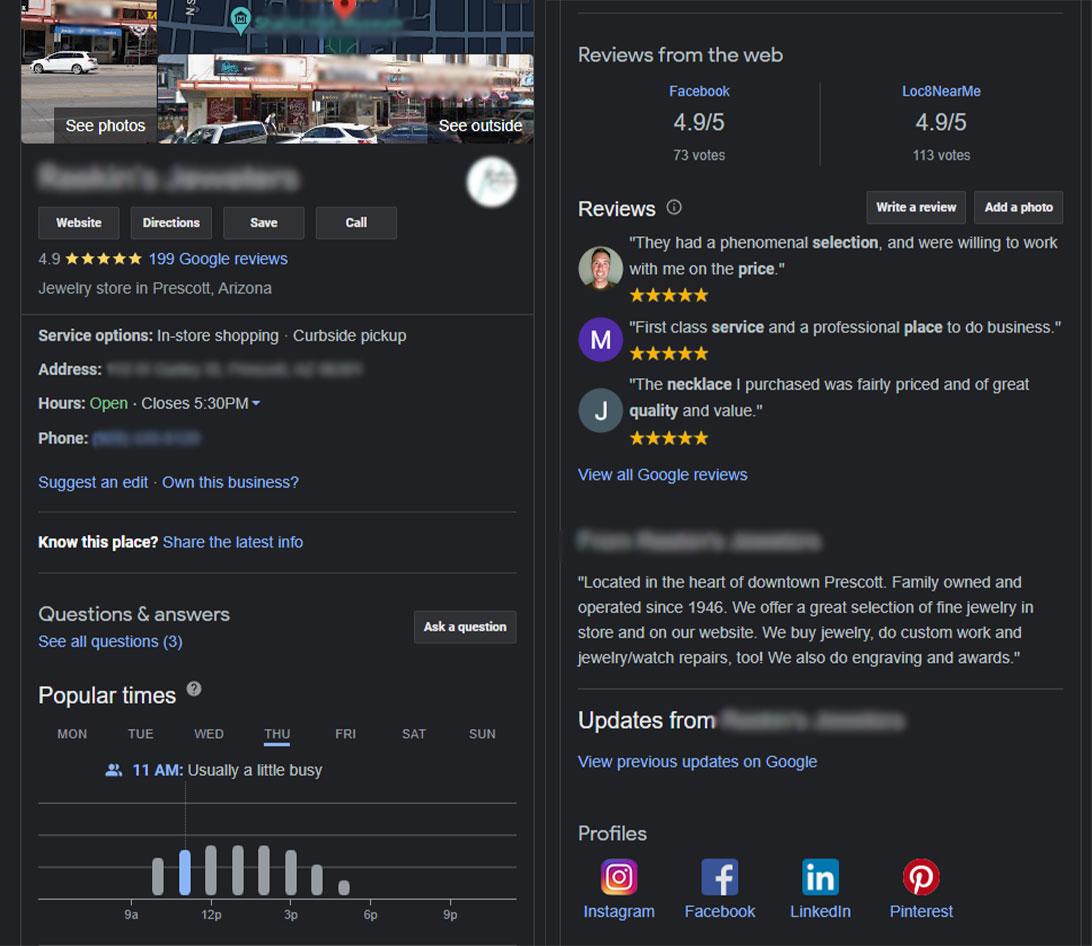
Your website platform likely has a way to either gather reviews right on your site or a plugin to pull in reviews from sites such as Google. You may have to do a little bit of research on exactly what’s available to your website.
Use SEO Everywhere You Sell Jewelry
These basics of SEO for your jewelry business can be used pretty much anywhere online. If you sell on an online marketplace, your keyword research will help your products show up in those searches. Pinterest and YouTube also take keywords into account when displaying results on their sites.
Getting High Quality Traffic To Your Website
The main purpose of implementing an SEO strategy for your jewelry business is to get high quality traffic to your website (or physical store). So how do you go about doing that? Branding and web design expert Arianne Foulks, found of Aeolidia, has these 5 tips for getting quality website traffic.
Good SEO
Implement the SEO tactics above! Once you've gained momentum in searches, it can feel like free traffic. Be sure to keep an eye on which keywords bring the most visitors to your website. Ideally you want a lot of traffic from people who haven't heard of you but want what you sell. So if you start seeing a lot of branded keywords popping up in your top keywords, you may want to readjust parts of your strategy to start reaching new customers.
- Check out Shopify's video course about SEO
- Learn more from Google
- Set up a Google Search Console account
Online Press and Publicity
Also known as influencers! If someone with an audience of their own is talking about you, they're helping to influence their followers in your direction. Whether it's a blogger with a large readership, a popular newsletter, or a social media account with a high following - they're all influencers. Pitch your business to niche publications that have an audience similar to your ideal customer. A single mention won't do much, so you have to work on a plan for repeated exposure to new audiences. Learn more about influencers in jewelry marketing >>
Social Media
The first step is to make sure you setup social media accounts and post to them regularly. But the next step is to make the content on your website easily shareable. This allows your customers to do some of the work for you by getting your content out of your own circle and in front of new people.
You may also want to consider joining online communities, such as Facebook groups. One option is to join a group related to your business. Be sure to pay attention to the rules of the group as some of them discourage selling, but it's a great way to network as well! The other option is to create your own group. Here you can set your own rules. As long as you provide value, your community may appreciate this kind of authentic and helpful selling tactic. Just be sure you're on the platforms that your ideal customers use.
Offline Press and Publicity
Create general brand recognition by promoting your business offline, in print publications, at in-person events, and/or your own brick and mortar store. This could include TV appearances, podcast ads or interviews, or any publicity that isn't clickable straight to your site.
However, Getting people from print or TV over to their phone or computer to type in your URL or to Google you is a lot to expect. So be sure that when you do meet customers in person you have marketing materials that direct them to your site. Perhaps a postcard, business card, or newsletter sign up. The best way to help your customers visit your site would be to put a QR code on your physical marketing materials! Allow them to easily scan a code to see your content right away.
Return Visitors and Word of Mouth
Bring in return visitors by making good use of your mailing list and providing a great customer experience. This is absolutely vital for an ecommerce business. The first step to customer retention is to make sure that your customer's experience is worth talking about. This means the ease of use of your website, the email follow-up about orders, the speed of shipment, the unboxing experience, and the product itself.
Once your customer has made a purchase, you're not done! Your relationship has just begun. Stay in touch with your customers by using a mailing list, offering special incentives, and showing that you value them. Always be approachable and engaged with customers on social media. You may want to share customer photos on social media or your website.
Further SEO Resources







